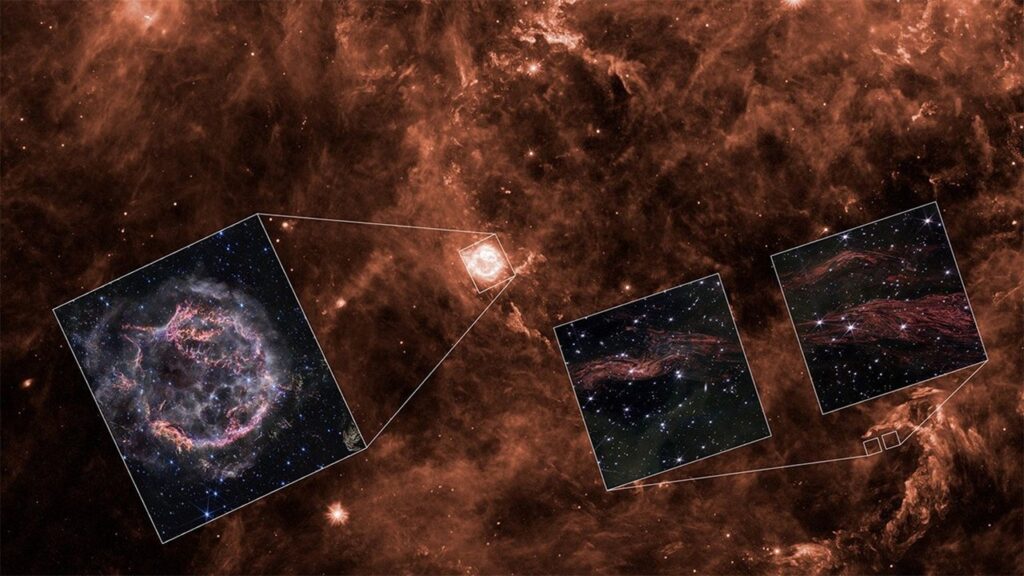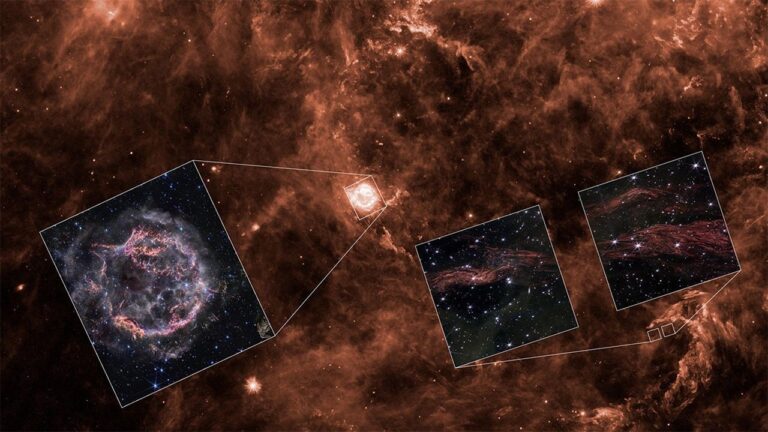NASA’s James Webb Space Telescope (JWST) has captured photos of one of the earliest supernovas ever seen, with features appearing like grains and knots found in a cut of wood.
“Once upon a time, the core of a massive star collapsed, creating a shockwave that blasted outward, ripping the star apart as it went,” NASA said on its website. “When the shockwave reached the star’s surface, it punched through, generating a brief, intense pulse of X-rays and ultraviolet light that traveled outward into the surrounding space.”
Now, nearly 350 years later, scientists are getting a view of the aftermath as the pulse of light reaches interstellar material and causes it to glow.
The infrared glow created was captured by JWST, revealing details that look like knots and whorls found in wood grain.
POWERFUL WEBB TELESCOPE CAPTURES MOST DISTANT KNOWN GALAXY, SCIENTISTS SAY

This background image of the region around supernova remnant Cassiopeia A was released by NASA’s Spitzer Space Telescope in 2008. By taking multiple images of this region over three years with Spitzer, researchers were able to examine a number of light echoes. Now, NASA’s James Webb Space Telescope has imaged some of these light echoes in much greater detail. Insets at lower right show one epoch of Webb observations, while the inset at left shows a Webb image of the central supernova remnant released in 2023. (Spitzer Image: NASA/JPL-Caltech/Y. Kim (Univ. of Arizona/Univ. of Chicago). Cassiopeia A Inset: NASA, ESA, CSA, STScI, Danny Milisavljevic (Purdue University), Ilse De Looze (UGent), Tea Temim (Princeton University). Light Echoes Inset: NASA, ESA, CSA, STScI, J. Jencson (Caltech/IPAC).)
“Even as a star dies, its light endures—echoing across the cosmos. It’s been an extraordinary three years since we launched NASA’s James Webb Space Telescope. Every image, every discovery, shows a portrait not only of the majesty of the universe but the power of the NASA team and the promise of international partnerships. This groundbreaking mission, NASA’s largest international space science collaboration, is a true testament to NASA’s ingenuity, teamwork, and pursuit of excellence,” NASA Administrator Bill Nelson said. “What a privilege it has been to oversee this monumental effort, shaped by the tireless dedication of thousands of scientists and engineers around the globe. This latest image beautifully captures the lasting legacy of Webb—a keyhole into the past and a mission that will inspire generations to come.”
While beautiful in nature, the observations also give astronomers the ability to map the 3-dimensional structure of the interstellar dust and gas for the first time.
“We were pretty shocked to see this level of detail,” Jacob Jencson of Caltech/IPAC in Pasadena, the principal investigator of the science program, said.
Josh Peek of the Space Telescope Science Institute in Baltimore is also a member of the team and said they see layers like those of an onion.
POWERFUL WEBB TELESCOPE SPIES SPECTACULAR STAR BIRTH CLUSTER BEYOND THE MILKY WAY

These shimmering cosmic curtains show interstellar gas and dust that has been heated by the flashbulb explosion of a long-ago supernova. (NASA, ESA, CSA, STScI, J. Jencson (Caltech/IPAC))
“We think every dense, dusty region that we see, and most of the ones we don’t see, look like this on the inside,” he said. “We just have never been able to look inside them before.”
The images produced from the JWST near-infrared camera (NIRCam) highlight a phenomenon called light echo, NASA said, which is created when a star explodes or erupts before flashing light into surrounding masses of dust and causing them to shine.
The visible light echoes are caused when the light reflects off interstellar material, where those at infrared wavelengths are caused when the dust is warmed by energetic radiation, causing it to glow.
Scientists targeted a light echo previously observed by NASA’s retired Spitzer Space Telescope, and it is one of dozens found near remains of the Cassiopeia A supernova.
MERGER OF MASSIVE BLACK HOLES FROM EARLY UNIVERSE UNCOVERED BY WEBB TELESCOPE, SCIENTISTS SAY

FILE – In this April 13, 2017 photo provided by NASA, technicians lift the mirror of the James Webb Space Telescope using a crane at the Goddard Space Flight Center in Greenbelt, Md. (Laura Betz/NASA via AP, File)
The Webb images show tightly packed sheets, with filaments displaying structures on what NASA called “remarkably small scales,” of about 400 astronomical units, or less than one-hundredth of a light year. One astronomical unit is the average distance between the Earth and the Sun, and Neptune’s orbit is 60 astronomical units in diameter.
“We did not know that the interstellar medium had structures on that small of a scale, let alone that it was sheet-like,” Peek said.
The discovery was compared by scientists to a medical CT scan.
“We have three slices taken at three different times, which will allow us to study the true 3D structure. It will completely change the way we study the interstellar medium,” Armin Rest of the Space Telescope Science Institute, and member of the team, said.
The team’s findings will be presented this week at the 245th American Astronomical Society meeting in Washington, D.C.
CLICK HERE TO GET THE FOX NEWS APP
The Webb Telescope, the successor to the Hubble and the largest telescope ever launched into space, is a joint project of NASA and the European Space Agency.
Greg Wehner is a breaking news reporter for Fox News Digital.
Story tips and ideas can be sent to Greg.Wehner@Fox.com and on Twitter @GregWehner.













